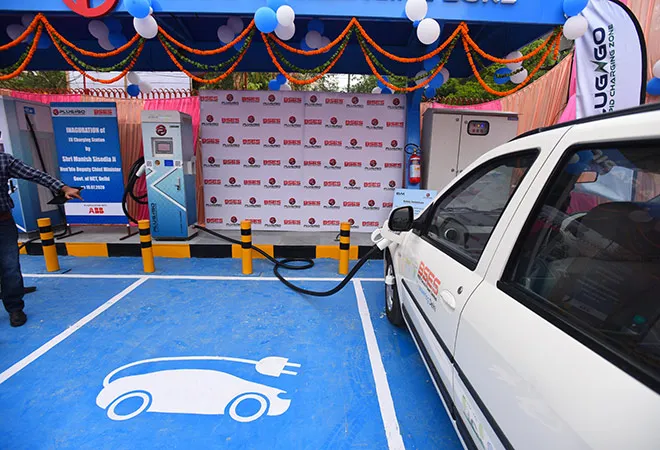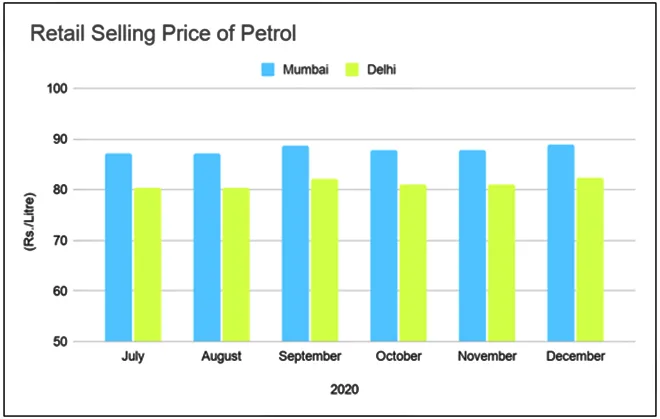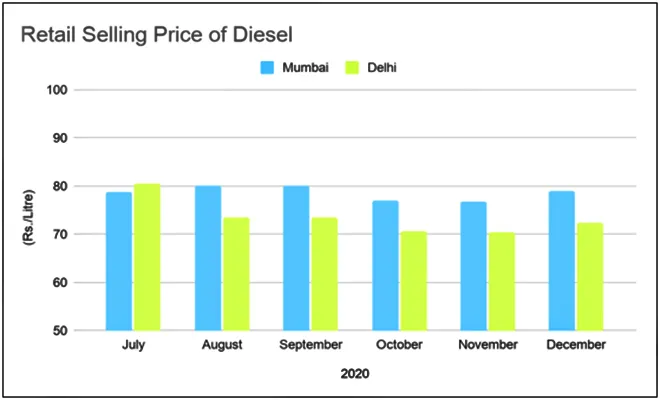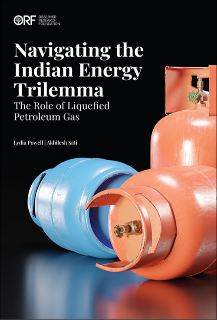
The electric vehicle (EV) with its zero-emission guarantee is the future of transportation. For a country with a population of 1.3 billion, ease of transport is a necessity. Indian transport contributes to around 10 percent of India’s carbon emissions. India is ready to branch out into a new sustainable way of transportation through the means of an electric vehicle. Before venturing into the sphere of electric vehicles, it is imperative to note the challenges in adopting EVs in India and analyse the trends in fuel pricing, thereby, making a case for switching to EV.
India’s e-mobility vision
In 2015, the government launched the Faster Adoption and Manufacturing of (Hybrid &) Electric Vehicles in India (FAME India) scheme to implement the goals of the National Electric Mobility Mission Plan, 2020. Phase one of the FAME India scheme had four focus areas. Two of these focus areas were demand creation and charging infrastructure. The government had also taken a few initiatives to promote e-mobility by lowering Goods and Services Tax (GST) on battery-operated vehicles and exempting permits. However, the government was unsuccessful in achieving its target of selling seven million EVs by 2020. The demand for EVs in India is still stagnant.
India is currently in phase two of the FAME India scheme with goals of the first phase yet to be completed. The EV sales surged up by 20 percent in FY20 but still not high enough to achieve the government’s target. The e-transport sector is growing positively but at a very slow pace which is not enough to contain the rising carbon emissions. With the private sector companies such as Mahindra, Tata, and Tesla stepping in to manufacture electric vehicles, there is hope that the adoption of e-mobility will get a much-needed boost. However, the private sector cannot sustain on its own; government intervention is needed to overcome challenges and make the necessary institutional arrangements.
A very small portion of the population is willing to buy an electric vehicle, but even among this population, many are hesitant due to the lack of charging infrastructure. Another hurdle when buying an EV is the price factor. The battery of an electric vehicle is what makes it so expensive. The large size of the battery and the material used for its production increase the manufacturing cost. Manufacturing costs are a big obstacle to small domestic manufacturers in the absence of government incentives. The high price is the primary reason why people choose fuel cars over electric cars. However, what most people fail to realise is the added cost of monthly fuel refills. Fuel prices in India, especially petrol prices, have been rising. In February 2021, the petrol prices were as high as INR 100. While EV costs a lot more compared to fuel cars, the regular expenses otherwise spent on petrol are drastically reduced.
 Source: Petroleum Planning & Analysis Cell
Source: Petroleum Planning & Analysis Cell
The tabulated data can be visually compared in the graph below.


Making a smarter choice
The retail selling price (RSP) data is taken for two metro cities of Mumbai and Delhi for the year 2020. The data informs us that the price of petrol in these two cities have been rising since July 2020, which marked the gradual easing of lockdown restrictions. Even amongst the two megacities, there seems to be a big price difference for petrol as well as diesel. Despite COVID-19, the consumption of petrol was higher because of the increase in the use of personal vehicles; once the lockdown lifted, people chose to stick to private vehicles for safety reasons. The rising trend of petrol pricing has been observed in India since 2014. Although the present price of petrol is at an all-time high.
While the EV is priced much higher compared to regular fuel cars, it is much more economical in the long run. As per the International Monetary Fund, an average Indian spends 17 percent of his/her income on fuel. EVs should, thus, be seen as an investment. Assuming an average driver uses 45 litres of petrol in a month, which is the standard fuel tank capacity, the driver spends approximately INR 12,000 in three months only on fuel. These estimates are based on the RSP data for January 2021 to March 2021, collected from the Petroleum Planning & Analysis Cell.
 The above price estimates vary by per capita fuel consumption and are much higher for some people. The EV has a minimum battery life of eight years and the charging cost is much lower compared to monthly expenditure on fuel. Fuel prices in India are high due to heavy taxation, which might increase further. Industrial fuel vehicles also cause supply disruptions due to a price hike. Moreover, oil imports heavily increase India’s import bill.
The above price estimates vary by per capita fuel consumption and are much higher for some people. The EV has a minimum battery life of eight years and the charging cost is much lower compared to monthly expenditure on fuel. Fuel prices in India are high due to heavy taxation, which might increase further. Industrial fuel vehicles also cause supply disruptions due to a price hike. Moreover, oil imports heavily increase India’s import bill.
Achieving India’s e-mobility goals
Indian transport is already witnessing a shift to e-transport. As per the third BRICS report by Goldman Sachs, India will have the largest private car volume by 2050. Keeping this in mind, the government should take measures to increase the demand for EVs as a choice for a private vehicle. Norway is the leading EV-owning country in the world. The country introduced various tax incentives on EVs, free charging, and toll exemptions to encourage its citizens to buy an EV. India, already in phase two of the FAME India scheme, can take such countries as an example during policymaking.
Initiatives that are similar to India’s ‘Go Electric’ campaign must be implemented by State governments. The government has already made efforts to encourage e-transport by gradually phasing out fuel-run public transport vehicles in some cities and replacing them with EVs. The Delhi government has adopted a lead-by-example approach with the decision to make all government vehicles switch to electric. But there is no firm EV policy in India. The majority of the State governments in India only have a draft policy. Only large metro cities have satisfactory e-mobility facilities and even amongst these cities there is insufficient charging infrastructure. The Union Budget 2021-2022 did not mention any new policies to aid electric vehicle production. There is much more incentive needed from the government to promote domestic manufacturing and innovation and create an environment conducive to development.
The Economic Survey 2019 highlighted the limited availability of charging infrastructure as a limitation to adopting EVs. But as of 2021, the cost of buying an EV seems to be a bigger priority so that supply does not outgrow demand in the future. Demand has been even badly hit due to the pandemic. Unemployment and inflation have taken away purchasing power from the people. The success of EV depends on the enthusiasm from both sides, the government and the people. While EV purchase seems to have been pushed a little further due to COVID, the right policymaking to correct economic disruptions gives hope to the adoption of electric vehicles soon.
Akanksha Shah is a research intern at ORF Mumbai.
The views expressed above belong to the author(s). ORF research and analyses now available on Telegram! Click here to access our curated content — blogs, longforms and interviews.




 Source: Petroleum Planning & Analysis Cell
Source: Petroleum Planning & Analysis Cell

 The above price estimates vary by per capita fuel consumption and are much higher for some people. The EV has a minimum battery life of
The above price estimates vary by per capita fuel consumption and are much higher for some people. The EV has a minimum battery life of  PREV
PREV

